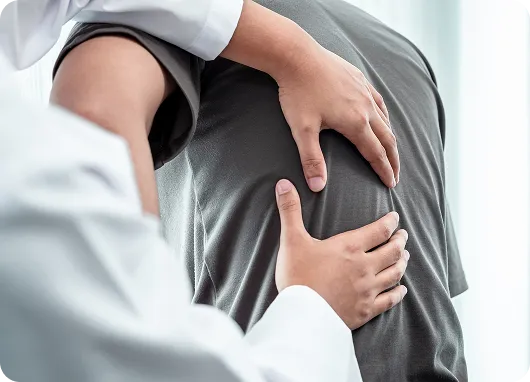Degenerative Disc Disease Treatment
Minimally invasive care to relieve pain, restore mobility, and protect spinal health

What Is Degenerative Disc Disease?
Degenerative disc disease occurs when the intervertebral discs (responsible for absorbing shock and providing flexibility to the spine) begin to break down due to aging, wear, or physical strain. As these discs deteriorate, the space for spinal nerves narrows, leading to pain, stiffness, and limited mobility.
Because symptoms often resemble general back pain, this condition can be overlooked or left untreated. Recognizing its impact and seeking early care is essential to prevent long-term complications.
What Is Degenerative Disc Disease?
Degenerative disc disease occurs when the intervertebral discs (responsible for absorbing shock and providing flexibility to the spine) begin to break down due to aging, wear, or physical strain. As these discs deteriorate, the space for spinal nerves narrows, leading to pain, stiffness, and limited mobility.
Because symptoms often resemble general back pain, this condition can be overlooked or left untreated. Recognizing its impact and seeking early care is essential to prevent long-term complications.

What Is Degenerative Disc Disease?
Intervertebral discs act as cushions between the vertebrae, helping absorb impact during movement and allowing flexibility in the spine. In degenerative disc disease (DDD), these discs gradually lose their structure and function.
As deterioration progresses, spinal movement becomes restricted, and symptoms like pain, numbness, or tingling (especially in the lower back and legs) can arise, affecting daily life and mobility.
Causes of Degenerative Disc Disease
Degenerative disc disease can develop due to a range of internal and external factors, including:
✔ Aging: With time, discs lose moisture and elasticity, reducing their shock-absorbing ability.
✔ Genetics: A family history of spinal disorders may increase risk.
✔ Lifestyle choices: Smoking, poor nutrition, and lack of physical activity can contribute to disc degeneration.
✔ Injuries and trauma: Sports injuries, accidents, or repeated stress on the spine can lead to disc damage.
Symptoms of Degenerative Disc Disease
Some of the most common symptoms of degenerative disc disease include:
Pain and discomfort in the lower back area
Limitations in the range of motions due to spinal stiffness
Nerve-related symptoms like tingling, weakness in the legs and back
Severity and progression of symptoms
Diagnosis of Degenerative Disc Disease
To determine the presence and severity of DDD, your healthcare provider will:
✔ Review your family medical history to identify possible genetic factors
✔ Conduct a physical examination of the lower back and legs to assess mobility and pain triggers
✔ Order imaging tests such as X-rays, MRIs, or CT scans to detect disc damage and evaluate spinal alignment
Treatment Options for Degenerative Disc Disease
Treatment is based on the severity of disc degeneration and the underlying cause. Options may include conservative therapies, medication, and advanced procedures.
Non-Invasive Physical Therapy
Non-invasive procedures use physical therapy or exercises to alleviate pain symptoms. These can be used along with other minimally invasive intervention options or non-opioid medication:
✔ Massage therapy: This therapy focuses on areas that are causing pain and discomfort, releasing pain and pressure from the lumbar area.
✔ Acupuncture: This type of conservative therapy uses needles to focus on pressure points, helping with the nerves that send pain signals into the brain.
✔ Chiropractic care: This kind of therapy uses manual techniques to align the spine.
Lifestyle Changes
Some tips that could help alleviate the symptoms of degenerative disc disease include:
✔ Performing low-impact exercises to strengthen the muscles around the spine and add flexibility to the lumbar area
✔ Following a balanced diet and healthy lifestyle to manage weight and reduce lumbar stress
✔ Using ergonomic chairs and having good posture reduces pressure and pain in your spine
Non-Opioid Medications
Non-opioid medications offered by your health specialist can help reduce spinal swelling and nerve pressure. These may include anti-inflammatory medications, muscle relaxants, and antidepressants. Depending on your case and the extent of wear in the intervertebral disc, your doctor will provide specific dosage instructions.
Injections
Unlike local anesthetics, injections offer longer-lasting relief for patients dealing with degenerative disc disease. Available options can include the following:
✔ Platelet-rich plasma (PRP) is derived from the patient’s own blood and contains multiple substances that promote tissue growth and regeneration.
✔ Stem cell therapy uses stem cells from multiple tissues of the patient’s own body and promotes tissue regeneration.
Pain Management Procedures
These procedures help interrupt pain signals and improve comfort, especially when combined with physical therapy:
✔ Steroid Injections: These are injected near the spinal nerve area, blocking the transmission of pain signals.
✔ Facet joint injections: These are targeted into the joints located on the vertebra, which could be causing nerve compression.
Neuromodulation
Neuromodulation is the medical technique of altering nerve activity using electrical stimulation. Its objective is to block the pain signals sent into the brain. These can help reduce the lumbar stress caused by degenerative disc disease:
✔ Spinal cord stimulation uses electrical impulses to modify the nerve activity in the spine, stopping pain from being felt.
✔ Peripheral nerve stimulation uses electrical stimulation to target peripheral nerves around the spinal cord.
Minimally Invasive Interventions
These procedures restore mobility and relieve pressure without large incisions or extended recovery:
✔ Microdiscectomy: Removes a portion of a damaged disc to reduce nerve compression
✔ Artificial disc replacement: Replaces a degenerated disc with an implant to maintain spinal function and motion

Care That’s Close to Home
We offer care from two convenient clinic locations, making it easy to access expert medical support close to home.
Each facility is designed to provide a welcoming, safe, and efficient environment equipped with advanced technology and supported by a compassionate team dedicated to your well being.
Care That’s Close to Home
We offer care from two convenient clinic locations, making it easy to access expert medical support close to home.
Each facility is designed to provide a welcoming, safe, and efficient environment equipped with advanced technology and supported by a compassionate team dedicated to your well being.

Why Choose Spinal Diagnostics?
Patients choose Spinal Diagnostics for our comprehensive approach, accurate diagnostics, and compassionate care. We stay at the forefront of interventional procedures and are committed to improving your quality of life without opioids or invasive surgeries.
Proven Medical Expertise
We bring years of clinical experience in pain management and interventional procedures.
Constant Innovation
We use the latest techniques and technology to ensure safe, effective treatment.
Compassionate Care
We listen, understand, and treat every patient with empathy and respect.
Personalized Plans
Each treatment is tailored to your condition, goals, and lifestyle.
Explore the treatments that bring real relief.
Learn how our non-invasive solutions and personalized plans can help you feel better, faster.
Explore the treatments that bring real relief.
Learn how our non-invasive solutions and personalized plans can help you feel better, faster.


